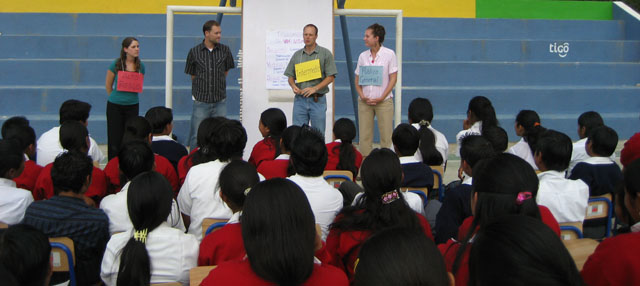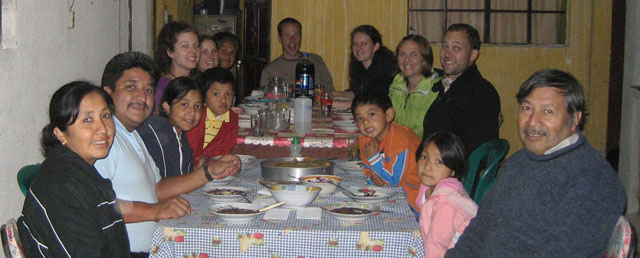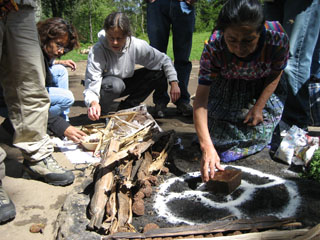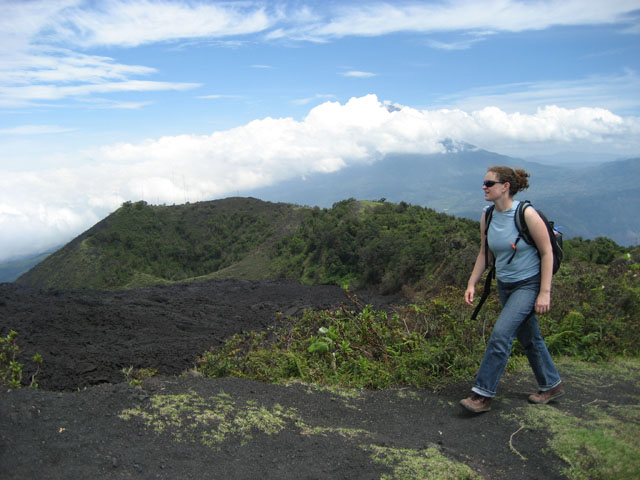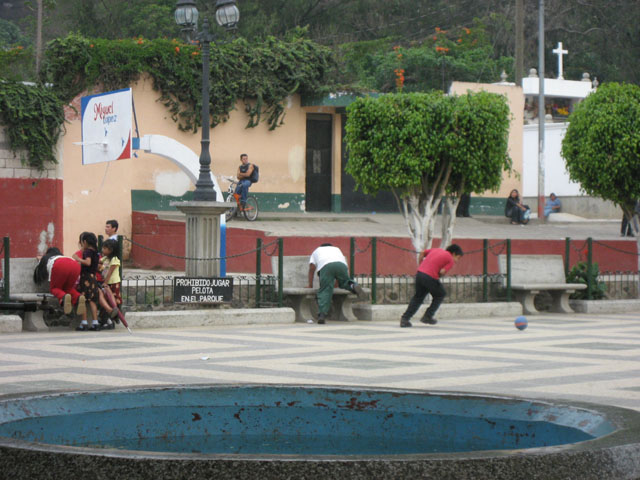June, 2008 Part II
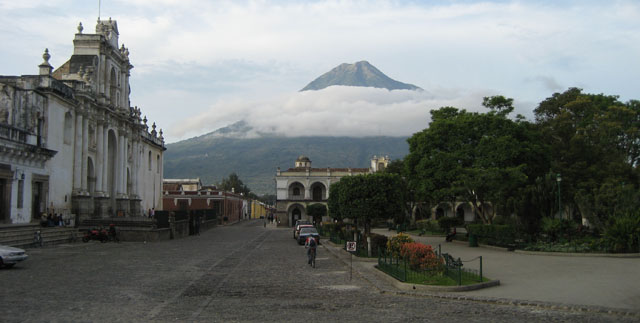 Antigua, the original capitol of Guatemala and where we go to get beer & nachos every now and then.
Antigua, the original capitol of Guatemala and where we go to get beer & nachos every now and then.
Hello, interested friends & relatives!
June has been a busy month, so I am going to do a second post. You might have noticed that the format of these has changed a bit; my friend Brian helped me to convert these letters from HTML to a blog. I’m going to continue posting this way to make it easier for us to administer, and for you to navigate. If you look to the right, there are options where you can view my older letters or look at Emily’s letters home. In addition, a the bottom there is a space to leave comments others can read. You have to create an account to do that, but it’s easy and safe- click on “register” and follow the directions. No one else will be able to see your email address, and Brian promised me he won’t sell it to anyone. :]
I never know if this is going to be boring for people or not, but I figure you’re all welcome to skip around and read the parts that sound interesting. Or just look at the pictures, for the semi-literate. Speaking of which, my Guatemala trivia for the day is that the literacy rate here is only about 60%. Yikes. I will talk a bit more about that in the “abject poverty” section. Anyways, email me if you want to hear about something I’ve not addressed, or just for the hell of it. I like getting email, and what seems mundane to you might be something i really want to hear about since I’m kindof isolated out here. Here’s the day’s menu:
- Abject poverty & health training
- Chili Cookoff
- Iximché: Mayan blessing ceremony
- Pacaya: Climbing a volcano
- Random weirdness– Maximún, toilets, etc.
I also wrote a huge description of our weeklong construction project in Quiché, but it was so long that I broke it into a separate post, to follow immediately. The only other thing of serious personal import right now is that we should be finding out our permanent site location in the next week or so. I will let everyone know when that happens, as it will be very exciting for me to know where I’m going to be for the next two years.
Abject poverty & health training
So I might have mentioned before that we’re also concentrating on health training. Basically, my team of 4 goes to two different villages regularly to teach seminars on things from AIDS prevention (the picture above is a presentation we gave to about 80 middleschool kids) all the way down to handwashing. AIDS is a huge problem in just about every 3rd world country, mostly because the people are uninformed about prevention, so educating them saves a lot of lives. But I was surprised to also find out that the problems here are a lot more basic. Check out these Guatemala statistics: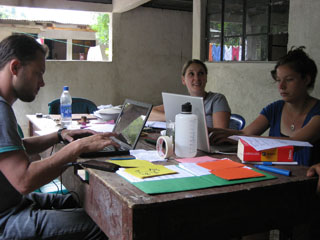
- The number one killer of children under age 5 is pneumonia, at 7,500 last year
- The second killer is diarrhea, at 2,000 dead
- The third killer is malnutrition, at 1,000 dead.
On top of that, there were 450,000 cases of hospitalization for intestinal parasites, and 350,000 hospitalizations for diarrhea. Much of this is preventable with basic hygiene practices like regular handwashing and latrine usage (as opposed to pooping in the street/ yard).
So, one of our jobs is to teach the locals how important hygiene is, and how to handle more technical things like boiling water to kill parasites, or to wash hands to prevent fecal-oral disease transmission. This is a surprisingly hard thing to do, in part because it is a touchy topic, but also because of silly things like the fact that much of the country folk can’t read. A few weeks ago, I accompanied a Guatemalan health worker on a routine visit to a few households, as she went to talk about health and hygiene. In this particular trip, i was just observing the technique of the health worker with the intent of helping them better their system in the future. But I wasn’t really prepared for what I saw.
First off, the family we visited was living in a barnyard fenced in with bamboo. Their goats, chickens, ducks, seminaked children, and cows were all ranging freely together in the dirt and excrement. In the center of the barnyard was a 20′ X 20′ concrete block shack with a corrugated tin roof (& dirt floor), with a dirty rag over the opening as a door. The mother and her mother appeared to listen to the health worker, as I watched and took mental notes. As the discussion progressed, I counted at least 8 children running around barefoot (hello, hookworm) with mud (i hope) smeared all over their clothes and faces. The two adult women were similarly dirty, and both had their hands in their mouths at some point in the talk (hello, pinworm/ roundwork/ amoebic dysentery/ hepatitis). The children were pretty timid for the most part, but several brave souls poked their heads around the corner of the shack to watch the gringo (me). One stood behind grandma holding her leg, and another was breastfeeding with mom as we talked.
This family had no running water or sanitary system. Likewise, judging from the smoke rolling out from the doorway, they cook on an open indoor fire (hello, respiratory infections) like many rural Guatemalans. I wish I could have taken a picture, so you would all believe me, but there was no way to do it without being REALLY offensive to these people. On top of that, many Guatemalans are really sensitive about cameras either because of ancient tribal beliefs about the soul, or because of the black market for stolen Guatemalan babies, or both.
I am not really a “go save the world” kind of guy, but it all really drove home the point that there are some VERY fundamental things that need to get worked out in 3rd world countries, sometimes even before we start thinking about constructing water infrastructure and building Habitats for Humanity. I still haven’t decided how I feel about all of this; it’s very heavy stuff. I had to take a shower when I got home.
(back to top)
Chili Cookoff
I had a fierce longing for some real American food, and wanted to share a little culture with my Guatemalan family, so I decided to have a Fiesta de Comida Americana. Based on what I thought I could hack together with local ingredients, I decided on the following menu:
- 3-bean chili with meat
- Cornbread
- Fruit salad
- Peanut butter cookies
- Coke
- Key lime pie
The fiesta turned into a giant party with my full family, as well as the Americans in my town. Anna and Emily Alta made the cookies and salad, and Joe and Katy helped with the cooking. My Emily got us some chicken for the chili. I have to say, it was probably the best evening I have had in Guatemala so far- the food turned out great, my host family loved it, I got to spend time with my new American friends, and a good time was had by all.
As an interesting side note, i won’t be able to do parties like this very often. I spent about 240 Quetzales on food, which is about 9 days pay for me, and left me financially tight for a while. But it was worth it. It’s funny how distorted a perspective you get here, though; Q240 equals about $35 American, which i normally wouldn’t think twice about back home. When I had a job.
(back to top)
Iximché and the Mayan Priestess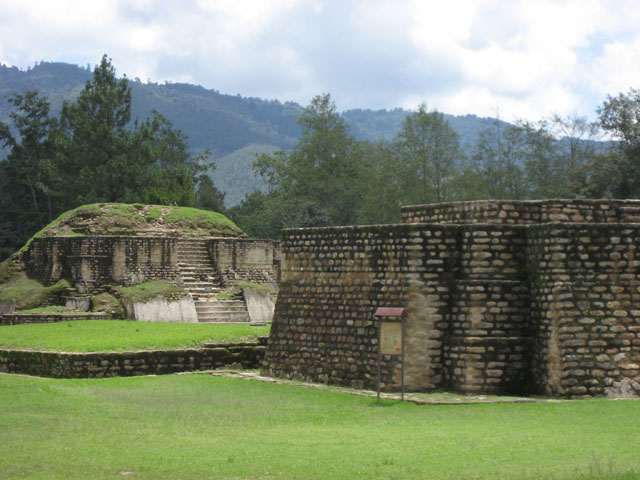
To get our service in Guatemala off on the right foot, we took part in a Mayan religious ceremony. We walked through the ruins of Iximché, an ancient Mayan capitol destroyed by the conquering Spaniards in the 1500s. At the ruins of the ancient temple, we met an elderly Mayan priestess. She wore the traditional dress of her people, the Quetchiquel, and spoke to us in slow but clear Spanish. She welcomed us on behalf of the people of Guatemala, and explained that today was a sacred day in the Mayan calendar, the “day of payment” where sacrifices are made to give thanks to the gods for all the good they’ve bestowed upon us. She had with her a large basket filled with sacrificial offerings, which she began to arrange on the circular altar stone. Sugar was poured out in a circle, indicating the wholeness of the universe, then crossed to connect the four points of the compass. Then, she placed an offering of honey and chocolate in the center, pleasing to the gods, followed by grain and berries at the cardinal points to complete the circle. 13 candles were arranged at each of the four directions, with different colors significant to the Maya: white in the north, for purity; yellow in the south, for the corn that gives them life; red in the east, for the blood that is daily existence; black in the west, for dying even as the sun is setting. Additional green and blue candles, representing the earth & sky, were then added to the offering. By this point, bees and flies were everywhere, as if the gods were impatient to accept the offering.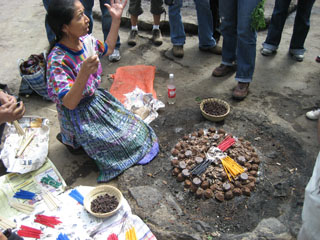
The priestess lit the pyre, and as the fire spread, we were each asked to take a few kernels of grain and two candles to add to the fire as our personal offering. The priestess added frankincense to the fire, and its sweet smell drifted across our circle. I selected a green and a blue candle, for the earth and sky that remind me of my spiritual home on the shores of Lake Superior. Each of us in turn added our offerings to the flames, and the priestess chanted benedictions in the ancient Quetchiquel tongue. Occasionally throughout the ceremony she would throw a handful of seeds on the pyre, popping and crackling; or sugar, hissing and releasing a sticky acrid smoke, folllowing some ancient and unspoken prescription.
The gods were pleased with our offering and our presence in this land, the Priestess explained, because the fire progressed in a tranquil and orderly manner. We continued until all of the sacrifices were consumed, then bade our farewell to Iximché.
(back to top)
Pacaya: climbing a volcano
Emily, hiking atop the volcano
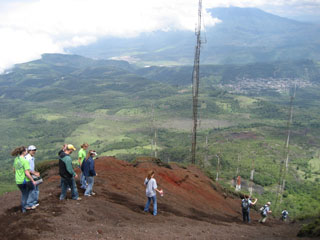 Guatemala has a lot of active volcanoes, several of which are right in our backyard. Former Peace Corps volunteers in Guatemala and friends of ours from Galesburg, Erin & Andy Crawford visited us last week. They brought with them 8 high school Spanish student from Erin’s class, and had a microbus at their disposal. This turned into a good chance to socialize, meet some adventurous Americans, and see Pacaya, a local active volcano. It was fun. Unlike Volcano National Park in Hawaii (which is awfully cool in its own right), you can actually go right up to the oozing glowing lava and poke sticks in it, etc. We roasted marshmallows over it and made s’mores. Also, the main cinder cone was active, making jet engine noises and occasionally spewing rocks into the air a few hundred meters above us.
Guatemala has a lot of active volcanoes, several of which are right in our backyard. Former Peace Corps volunteers in Guatemala and friends of ours from Galesburg, Erin & Andy Crawford visited us last week. They brought with them 8 high school Spanish student from Erin’s class, and had a microbus at their disposal. This turned into a good chance to socialize, meet some adventurous Americans, and see Pacaya, a local active volcano. It was fun. Unlike Volcano National Park in Hawaii (which is awfully cool in its own right), you can actually go right up to the oozing glowing lava and poke sticks in it, etc. We roasted marshmallows over it and made s’mores. Also, the main cinder cone was active, making jet engine noises and occasionally spewing rocks into the air a few hundred meters above us.
The trip down the mountain was equally fun, and we got to “ski” through a steep talus slope of pea-sized pumice stone. The trip up took about an hour and a quarter; we shaved about an hour off of it on the way back by sliding down the back side of the volcano (picture above right).
Random Weirdness: Maximún, toilets, and whatnot
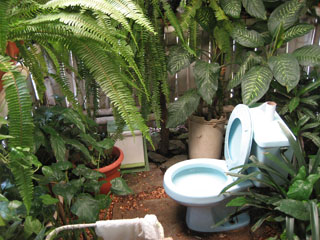 I must admit, this part is kindof the most fun. We’ll jump right in with the Toilet of the Day. We stumbled across this one in a macadamia nut farm; our coworkers in Dueñas nominated it as the Best Toilet in Guatemala.
I must admit, this part is kindof the most fun. We’ll jump right in with the Toilet of the Day. We stumbled across this one in a macadamia nut farm; our coworkers in Dueñas nominated it as the Best Toilet in Guatemala.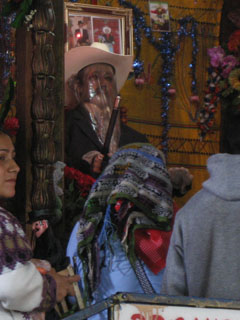
Next we have Maximún, a local god of love, hate, sex, money, or anything else you fancy. He operates in some of the same spheres as the Mayan gods previously mentioned, but he is kindof a more shadowy entity. To further complicate things, he was once a saint in the Catholic Church (San Simone), but they exorcised him when they found out that he was up to non-catholic things like hooking up lovers and blessing crops. He hangs out in a former catholic church he commandeered, his “priests” blessing those who need it by spitting rum over their eager bodies, or smoking fat Cuban cigars and puffing smoke on them. Very strange. Offerings include candles, articles of clothing, chocolate, and his favorite: cheap rum. I am really lucky I got this picture of him (i find him kindof creepy) as supplicants pass before his altar; we were granted photo permission from one of the priests, but after we took some pictures, a half drunk petitioner threatened Emily Alta with some pretty harsh words.
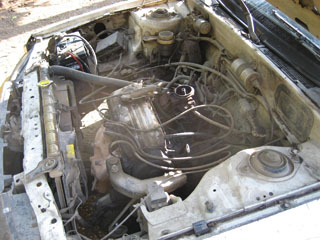 All the cars here are about 20 years out of date, trucked in from the US. Many still have stickers like an Ohio DOT inspection sticker or Dulles Airport Parking on them. I learned a lot about cars from my friend Jerry in the last few years, so when the family car was on the fritz the other day, I though I’d have a look under the hood. I was pretty appalled to see this. Note the gaping hole in the carb where the air filter isn’t. Heh.
All the cars here are about 20 years out of date, trucked in from the US. Many still have stickers like an Ohio DOT inspection sticker or Dulles Airport Parking on them. I learned a lot about cars from my friend Jerry in the last few years, so when the family car was on the fritz the other day, I though I’d have a look under the hood. I was pretty appalled to see this. Note the gaping hole in the carb where the air filter isn’t. Heh.
And last but not least, a bit of cultural humor. No one here reads signs, let along obeys silly laws. Here we have some kids playing soccer in the town plaza. The sign by the bench reads “prohibido jugar pelota en el parque”. For the non-Spanish speakers out there, that is “playing with balls is prohibited in the park.” Well done.
